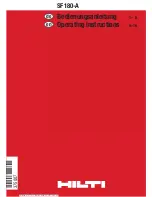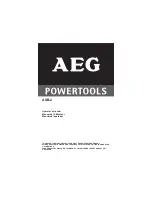
7
cold, it automatically starts a Hot/Cold Pack
Delay, suspending charging until the battery
has normalized. After this happens, the
charger automatically switches to the Pack
Charging mode. This feature ensures
maximum battery life. The red LED flashes in
the pattern indicated on the label when the
hot / cold pack delay is detected.
LEAVING THE BATTERY IN THE CHARGER
The charger and battery pack can be left
connected with the green LED glowing
indefinitely. The charger will keep the
battery pack fresh and fully charged.
IMPORTANT CHARGING NOTES
1. Longest life and best performance
can be obtained if the battery pack is
charged when the air temperature is
between 65°F and 75°F (18°- 24°C).
DO NOT charge the battery pack in an
air temperature below +40°F (+4.5°C),
or above +105°F (+40.5°C). This is
important and will prevent serious
damage to the battery pack.
2. The charger and battery pack may
become warm to touch while charging.
This is a normal condition, and does
not indicate a problem. To facilitate the
cooling of the battery pack after use,
avoid placing the charger or battery pack
in a warm environment such as in a
metal shed, or an uninsulated trailer.
3. If the battery pack does not charge properly:
a. Check current at receptacle by
plugging in a lamp or other appliance
b. Check to see if receptacle is
connected to a light switch which turns
power off when you turn out the lights.
c. Move charger and battery pack to a
location where the surrounding air
temperature is approximately 65°F -
75°F (18°- 24°C).
d. If charging problems persist, take
the tool, battery pack and charger to
your local service center.
4. The battery pack should be recharged
when it fails to produce sufficient power on
jobs which were easily done previously.
DO NOT CONTINUE to use under these
conditions. Follow the charging procedure.
You may also charge a partially used pack
whenever you desire with no adverse
affect on the battery pack.
5. Foreign materials of a conductive nature
such as, but not limited to, steel wool,
aluminum foil, or any buildup of metallic
particles should be kept away from
charger cavities. Always unplug the
charger from the power supply when there
is no battery pack in the cavity. Unplug
charger before attempting to clean.
6. Do not freeze or immerse charger in
water or any other liquid.
WARNING:
Shock hazard. Do not
allow any liquid to get inside charger. Never
attempt to open the battery pack for any
reason. If the plastic housing of the battery
pack breaks or cracks, return to a service
center for recycling.
SAFETY WARNINGS AND
INSTRUCTIONS: DRILLS
1. Hold drill firmly with one hand on the
grip and the other hand on the bottom
of the battery pack.
2. When attaching accessories in the drill
chuck, hand tighten the keyless chuck firmly.
WARNING:
Drill may stall (if overloaded
or improperly used) causing a twist. Always
expect the stall. Grip the drill firmly with both
hands to control the twisting action and
prevent loss of control which could cause
personal injury. If a stall does occur, release
the trigger immediately and determine the
reason for the stall before restarting.
INSTALLING AND REMOVING THE
BATTERY PACK FROM THE TOOL
WARNING:
Make certain the lock-off
button is engaged to prevent switch actuation
before removing or installing battery.
TO INSTALL BATTERY PACK: Insert
battery pack (6) into tool until an audible click
is heard (figure B). Make sure battery pack
is fully seated and fully latched into position.
TO REMOVE BATTERY PACK: Depress
the battery release button (7) as shown in
figure C and pull battery pack out of tool.
B
6
C
7




























